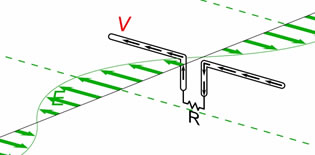“Magnetic Loop Antenna”
|
||||||||
|
||||||||
 Source: Field Antenna http://www.purple.dti.ne.jp/fieldant/index.html “©2013 Munekazu Yoshimura, used with permission |
You heard so much about this mysterious small loop antenna that works on all HF bands. A small size. Like invisible to the HoA. Is that for real? How does it work? Does it really actually work? How can it be so small? The purpose of this writing is to answer these questions and explain what this mysterious antenna is all about, without getting too theoretical. |
|||||||
First, what is an antenna? |
||||||||
 Electromagnetic Field has two component  Dipole antenna is an E-field antenna |
Electromagnetic Field? I mentioned “electromagnetic field. You might be familiar with the term electric field, what is electromagnetic field? Well they are the same thing. Electric field and magnetic field are light and shadow, ying and yang, different faces of the same phenomena. They always go neck and neck, as in one begets the other, and vice versa. Two Antenna Types |
|||||||
| What’s the Difference? So there are two types of antenna, one generates E-field, the other, M-field. I said earlier that E-field begets the M-field, M-field begets E-field. If they are neck-and-neck, what is the difference? To explain that, I’ll have to talk about far-field and near-field. When we talk about gain and directionality of antenna, we are always talking about far-field effect. I’m talking about distance between the antenna and the “other station”, miles and miles away. Where is the border between the near and far? For a practical purpose, 1 wave length in radius. That's how far the initial field is dominant. It is difficult to imagine the complex behavior of near-field (see the image below: rather chaotic, is it no?). But imagine this: Within one wave length of a loop antenna, the emitted EM field is mostly magnetic, before the E-field is induced by it. |
||||||||
 Near Field plot of a loop antenna |
We are more familiar with E-field behavior. It is easily bent, shielded, and/or attenuated with nearby conductors, i.e., metal surfaces. That’s why E-field antenna behaviors (radiation, directionality, SWR) are affected by its surroundings. We are not as accustomed to M-field. It is not affected by the surrounding metal. You can bend, but not as easily shielded, like E-field. It passes through most conductive object. It is affected by magnetic materials, but generally you don’t have much magnets around your household. Even if you have electric motors, compressors, etc., they are very concentrated in a small area, which are not likely to interfere with an antenna in a significant way. This is why the magnetic antenna can be tuned to optimum match and radiation, mostly independent of its surroundings. Magic, isn’t it? |
|||||||
| So What Makes an Antenna Magnetic? You heard about the “small” magnetic antenna. What makes it magnetic, and why can that be so small? Well the truth is, it’s magnetic because it’s small. An E-field antenna generates E-field using the voltage difference between points on the antenna element (wire). This is why its antenna element is related to its wavelength. |
||||||||
 Current distribution around loop antenna Source: https://www.nonstopsystems.com/radio/frank_radio_antenna_magloop.htm ©2012 Frank Doerenberg N4SPP, used with permission |
||||||||
An M-field antenna generates M-field using the current flowing through its element. To do this, the current must be (close to) constant across the element. Therefore its element length must be 10% of the wavelength or less. As you can see on the diagram above, 0.1 wave length loop keeps 95% of peak current at the edges. Longer loop has smaller current at the edges, resulting in more E-field effect mixed. Of course, It is NOT shorter the better situation. For one thing, just a wire of 0.1 wavelength cannot be matched to your transmitter. Matching mechanism must be added. But let’s keep that for a later discussion. What’s So Good about Magnetic Antenna? Questions, comments, opinions, etc. all e-mail to me |
||||||||
|
||||||||